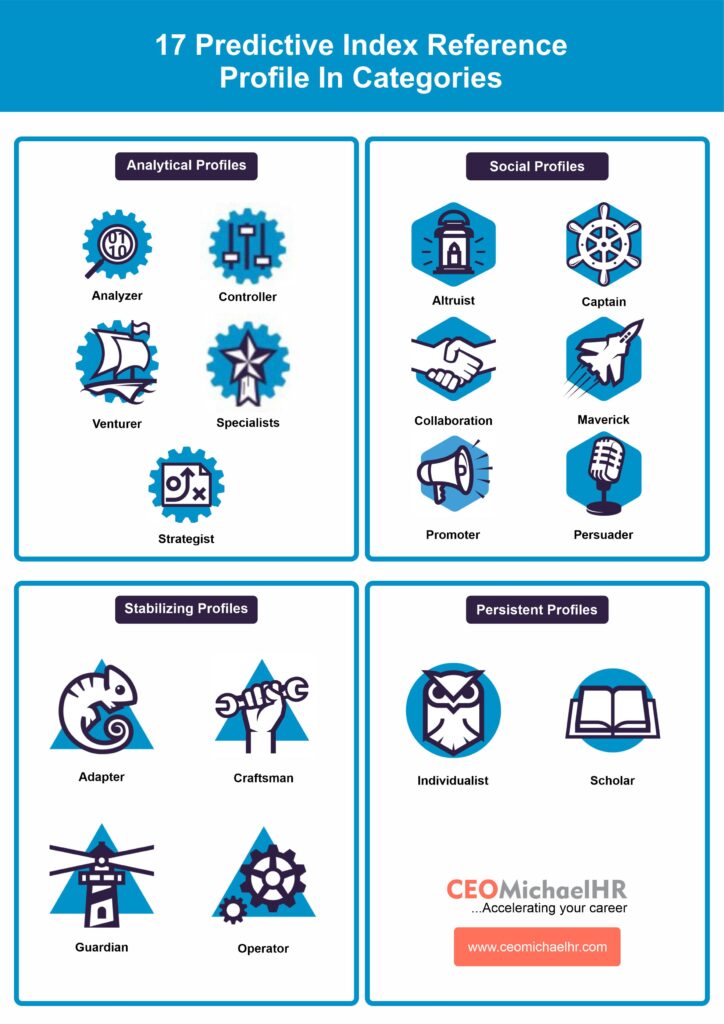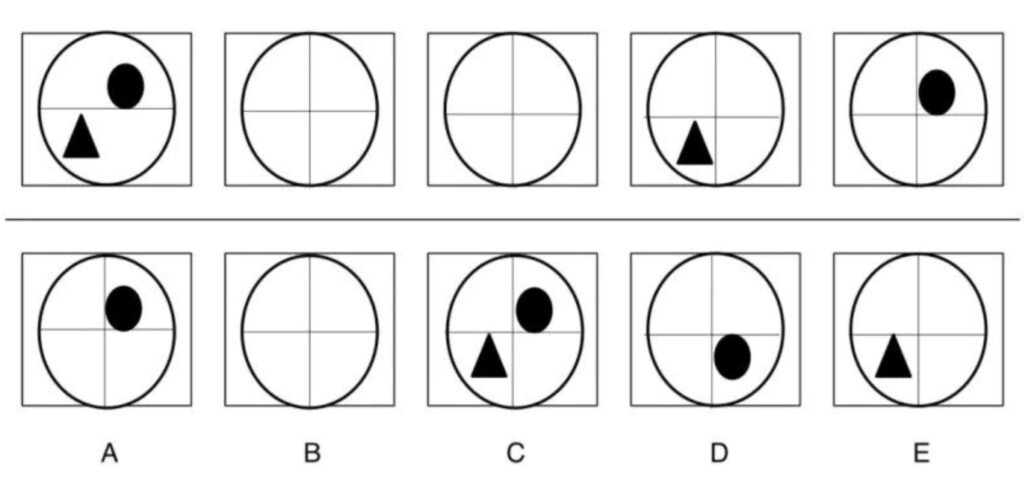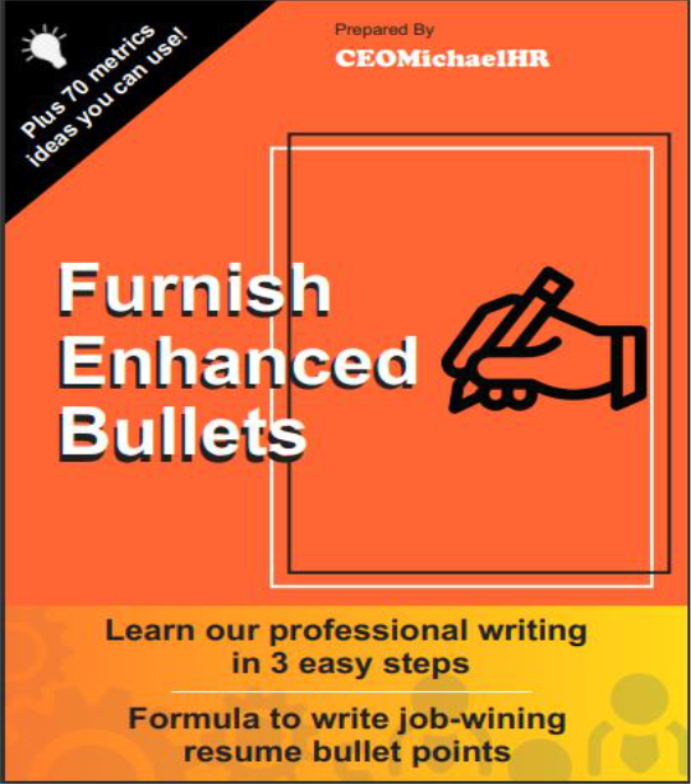
New clients, unlock 10% off all plans 🔥 at checkout with code: CEO10SPECIAL (Limited Time Offer)
New clients, unlock 10% off all plans 🔥 at checkout with code: CEO10SPECIAL (Limited Time Offer)






In simple terms, the Predictive Index (PI) test is an evaluation test that aligns business strategy with people strategy for optimal business results.
The PI test used to be known as the Professional Learning Indicator (PLI) test.
It typically serves as a personality test given by recruiters to analyze how well a potential employee fits the role they are looking to fill within an organization.
Using a Predictive Index test allows employers to evaluate a potential employee’s cognitive abilities, personality traits, and behavioral tendencies to ascertain if they are the right fit.
Employers use two main types of Predictive Index Tests when assessing applicants: the Predictive Index Behavioral Assessment (PIBA) and the Predictive Index Cognitive Assessment (PICA).
The PI Behavioral Assessment measures behavioral drives such as Dominance, Extraversion, Patience, and Formality, while the PI Cognitive Assessment identifies candidates with high potential for successful on-the-job performance by evaluating their cognitive abilities.
The PI Cognitive Assessment indicates a potential employee’s trainability for positions at all levels of an organization. It also facilitates the acceleration of onboarding and an employee’s ability to manage dynamic business environments.
The PI test is essential for determining the behavioral traits and cognitive abilities an employee would require to succeed in an organization.
Find out: 15 Jobs For Extroverts And Expert Communicators
The Predictive Index scores from candidates are essential for effectively narrowing a group of applicants while eliminating any bias unbeknownst to the employer.
Candidates with high scores would be considered to advance to the next stage in the recruitment process.
For this reason, candidates need to prepare well for the Predictive Index test.
An excellent Predictive Index score is anchored on the scale score, a percentile grade of the raw CA scores ranging between 100 to 450.
“Scaled scores are calculated to be comparable and standardized for everyone. So, anyone who received a scaled score of 270 is always a good match for a job with a target of 270, regardless of which form of the assessment was administered.”
It is essential to understand that both the PI Behavioral and Cognitive Assessment tests are qualitative and do not have right or wrong answers.
Your results on the PI Cognitive Assessment test are expressed as a raw score, which represents your total number of correct answers.
This raw score will then be converted into a scaled score and sorted into a percentile, allowing for a comparison with other applicants.
On average, you can expect to achieve a raw score of about 20 correct answers (between 17 and 23).
The scaled score ranges from 100 to 450, with the average score being 250.
Each employer can determine its own target PI Cognitive Assessment score for a given job role based on its company requirements.
Find out: 10+4 Reasons Why It’s Ok To Quit Your Job
Four critical drives are considered by the Predictive Index Behavioral Assessment when measuring workplace behavior: Dominance, Extraversion, Patience, and Formality.
Dominance: This drive demonstrates an individual’s ability to exert influence over other people or events. While low-dominance individuals exhibit a more collaborative and cooperative personality, high-dominance individuals are independent, assertive, and adept at handling conflicts.
Extraversion: This drive reflects strong social interaction. While low-extraversion individuals value privacy, reflection, and analysis, high-extraversion people seek connection, appreciate recognition, and are highly sociable.
Patience: This drive values consistency and stability. While low-patience individuals thrive on variety, work quickly, and can multitask, high-patience people prefer steady paces and are generally stable and loyal to their organizations.
Formality: This drive demonstrates an individual’s ability to conform to rules and structure. While low-formality individuals require freedom and flexibility, tolerate ambiguity and spontaneity, high-formality people exhibit strong discipline. They ensure clear expectations to minimize the risk of errors for the company they work for.
Find out: 450+ Words To Describe Yourself: Interview Tips
The Predictive Index Test does not have a pass or fail grade measurement, which means there are no right or wrong answers.
A sincere response will benefit both you and your hiring manager.
In another case, your response could influence other applicants depending on the position they are applying for.
The Predictive Index test is not only concerned with how a candidate fits into a job opening; it also helps candidates find employment in jobs that best suit them.
Over time, the Predictive Index Cognitive Assessment (PICA) has become the preferred choice, allowing you to select as many or as few word forms as you see fit.
The Predictive Index Cognitive Assessment (PICA) is different in its style of inquiry as it provides evidence about some assessment takers and offers more concrete answers than any other type of personality assessment test.
To gain a clearer understanding of the company’s culture and values, you can inquire with the hiring manager beforehand.
In the end, your expectations may differ from what the hiring manager is seeking in you.
Find out: 32 Best Paying Jobs in Finance Consumer Services
Any employee who decides to take a Behavioral Assessment (BA) and Cognitive Assessment (CA) must accept that everyone has unique behavioral patterns.
Since the purpose of the Predictive Index is to hire candidates who can fit in, there are seventeen different reference profiles to assist in matching individuals with similar patterns.
The classification into groups is purely scientific. However, like any behavioral data point, a reference profile is only as valuable as the other data it’s applied with.
Below are the 17 Predictive Index reference profiles:

Analyzer
Analyzers tend to demand a lot of details and will collect all relevant facts before forming a decision.
Controller
Controllers are fast-paced and self-disciplined. They are constantly pushing themselves to get things done correctly.
Venturer
Venturers are constantly pushing past and exploring boundaries. They look for ways to drive the business forward.
Specialists
Specialists are introspective, err on the side of caution, and are very loyal to authority.
Strategist
The strategist looks at the big picture. They look toward the future and consider how decisions can benefit the business.
Altruist
Altruists are accurate, supportive, humble, and helpful workplace colleagues.
Captain
These individuals have a strong will, are very independent, and are open to any change.
Collaborator
Collaborators are often characterized as empathetic, cooperative, and patient.
Maverick
These individuals tend to adopt leadership positions. They are visionaries and have high aspirations.
Promoter
Promoters are extroverted and charismatic. They are popular and widely loved.
Persuader
Persuaders don’t easily take no for an answer. They are well-spoken and likable, and they know how to motivate others.
Adapter
Adapters can take on different types of roles. They are typical generalists.
Craftsman
These individuals listen more than they talk and are reliable workers.
Guardian
Guardians tend to bring precision and structure to their place of work.
Operator
Operators are informal, relaxed, and reliable individuals. They tend to be patient and cooperative.
Individualist
Individualists are strong-minded and tackle challenges with confidence. They are analytical and persistent.
Scholar
Scholars are knowledgeable yet reserved individuals.
Intending to know how long a Predictive Index test takes to complete is like trying to understand how reliably fast the test tool can yield results.
The PI Cognitive Assessment is a timed assessment that takes 12 minutes to complete.
It’s used with the PI Job Assessment, and each candidate experiences a unique set of questions.
Find out: How Long Does A Background Check Take? – Full Guide
The objective of the predictive Index cognitive assessment is to assess a candidate’s cognitive ability, critical thinking, and reasoning skills in a single assessment.
These assessments contain verbal, numerical, and abstract reasoning questions.
The following are the three categories of questions with each devoted to one of the reasoning types:
These types of questions are drafted from short passages to assess your comprehension skills.
These questions are made up to assess your ability to rapidly handle numerical problems featuring percentages, fractions, ratios, algebra, data interpretation, and number sequences.
These involve identifying the relationship rule(s) within a sequence or pattern.
The assessment has 50 questions and is to be attempted within 12 minutes.
During this limited time, you will need to be able to digest and process tougher information at a rapid pace.
Find out: What to Wear to a Summer Interview
Example of a verbal reasoning practice question:
Statement:
The primary activity of a derivative’s trader and a gambler are analogous.
1) True
2) False
3) Cannot tell
The correct answer is True.
Trading is described as making ‘large bets’, which is similar (analogous) to a gambler’s main activity of gambling.
Example of a numerical reasoning practice question:
What is the gross margin in quarter 2?
1) $1600m
2) $1700m
3) $1800m
4) $1900m
The correct answer is $1700m.
Step 1: Calculate the revenue in quarter 2 ($36,500 x 28% = $10,220M)
Step 2: Calculate the gross margin ($10,220 x 16.63% = $1,700M)
Example of an abstract reasoning practice question:
Which of the boxes comes next in the sequence?

The correct answer is B
From the image above, the circle maintains the same position in the top right segment for one turn and is not present for the following three turns.
Triangle maintains the same position in the bottom left segment for one turn and is not present for the following two turns.
Below are the three major tips that will boost your success rate during the PICA.
Find out: How to Get Headhunted: Thrill of the (Job) hunt
The concept of the predictive index has been described as one of the fastest means to assess candidates and evaluate how well they can fit into an open job role.
Companies that adopt the PICA and PIBA have also confirmed that this system is trusted and accurate for their insights, resulting in regular use.
Companies that uses the predictive index test include:
Well, to some extent not all positions or departments may require the use of a Predictive Index Assessment result.
Predictive Index is a company with over sixty (60) years of proven science, software, and an excellent curriculum of insightful management workshops.
It has long become a solution adopted by numerous companies who look forward to creating a great team and culture, fostering objective hiring decisions, and inspiring greatness in their people all around the globe.
Mike Zani is CEO of The Predictive Index.
He is committed to providing an overall strategic direction for the organization, focusing on global growth and product development to gear excellent client results.
Daniel Muzquiz is President and Chairman of The Predictive Index.
He is responsible for executing corporate strategy by overseeing internal operations, including technology, finance, business analytics, and science.
Daniel is also a founding partner at Phoenix Strategy Investments, a private equity firm.
The Predictive Index Behavioral Assessment is based on honest and personal insight, and within 12 minutes, it’s completed.
Find out: 7 Tips for The Morning of Your Interview
In the predictive index, a Maverick is seen as a natural leader.
They are task-oriented and very persistent when given a goal and the freedom to pursue and achieve the set goals.
Mavericks are team players by default rather than by intention.
They are always strategic and utilize a data-driven approach in building teams that will assist industries in succeeding.
Characteristics of a Maverick
The following are the qualities that make up a Maverick:
Natural Strengths
Common Drivers
Blind Spots
Altruists are natural team players. They’re known to be people-oriented, cooperative, and accommodating.
They thrive and help contribute to a culture of teamwork.
They demonstrate a strategic, data-driven approach to building teams that helps organizations win.
Characteristics of the Altruist
The following qualities defines an Altruist:
Natural strength
Common Drivers
Blind Spots
Find out: Personal Branding+ Infographics: Tips Critical to Your Career’s Future
Captains love rising to meet challenges. Independent and strong-willed, they connect easily with colleagues and direct reports.
They’re natural leaders who inspire, challenge their teams, and raise the bar for their organizations.
Characteristics of a Captain
Here are the qualities of a captain in Predictive Index:
Natural Strengths
Common Drivers
Blind Spots
The Strategist in the Predictive Index represents a big picture of a person who projects ahead and thinks about how decisions will benefit the entire organization.
They’re decisive, no-nonsense people who like close control of their work.
Characteristics of a Strategist
Below are the strong characteristics of a strategist
Natural Strengths
Common Drivers
Blind Spots
Listed below are seventeen (17) of The Predictive Index profiles:
The Predictive Index test mitigates bias during the selection process. It assesses abstract intelligence in a high-pressure environment, allowing employers to gauge candidates’ ability to learn based on their quick responses, decision-making patterns, and readiness to adapt to new situations.
Cognitive ability is the sole predictor that mirrors an individual’s workplace performance. Only the Predictive Index test can provide employers with insights into your performance when hired.
Find out: How To Answer “Where Do You See Yourself In 5 Years?”
The Predictive Index tests are scored differently from other assessments because the ideal result differs according to the job function.
When a candidate scores 50 or above in PICA, Predictive Index publishes a list of expected scores for each job role.
The PIBA will reflect a personality reference profile.
You are expected to practice every question to become familiar with the answers.
Doing this under time constraints enhances your readiness to ensure outstanding performance on the predictive index test.
You should be able to cover the numerical, verbal, and abstract reasoning questions during your preparatory stage.
In the predictive index test, there’s nothing like pass or fail scores, but rather a target to indicate whether you are a good fit for the position or not.
There is a target score attached to some selected occupations.
You should aim to score the right points for your desired job role.
Find out: Bad Resume Examples: The 6 Mistakes You Definitely Should Avoid
We trust that this article has enriched you with extensive knowledge of the Predictive Index and how you can prepare for it.
A Predictive Index test benefits employers as it helps them learn more about a candidate’s fitness for a job position.
The idea behind the PICA and PIBA tools is to provide an honest and deeper insight into a candidate’s abilities, motivation, and passion for the job.
There’s a need for constant practice and rapid familiarization with questions in PICA, as it is challenging to attempt numerous questions within a short time.
PICA is about 20/50. Therefore, you need to aim high to progress to the next stage in your recruitment process.
Since the PIBA assists hiring managers in identifying employees’ behavioral patterns and personality traits, you must be honest.
Being truthful in the PIB Assessment can help you understand more about yourself and the ways you may prefer to work, even if you don’t advance to the next stage.
The concept here is that PICA and PIBA can influence great teamwork and improve an employee’s skill set accordingly.
With proper preparation and some luck, you’ll secure employment.
Want to save time and have your interview-ready resume in just 2-5 days? Let our CEOMichaelHR-certified resume writers take the guesswork out of resume writing by summing up and showing off your metric-driven experience and skills.
Share
Further Reading
*The names and logos of the companies referred to in this page are all trademarks of their respective holders. Unless specifically stated otherwise, such references are not intended to imply any affiliation or association with CEOMichaelHR.
Land interviews 3x faster while submitting fewer resumes
Copyright © 2025, ceomichaelhr.com.
All rights reserved.
Land interviews 3x faster while submitting fewer resumes
Copyright © 2025, ceomichaelhr.com.
All rights reserved.

Learn the same techniques our expert resume writers have used to get thousands of clients closer to their next job
Unlock expert resume tips, start landing multiple interviews!

Stay connected to receive powerful career insights, updates, and inspiration that’ll help you hit your career goals.